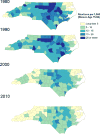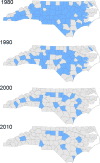Trends in Abortion Incidence and Availability in North Carolina, 1980-2013
- PMID: 29100222
- PMCID: PMC5672819
- DOI: 10.14423/SMJ.0000000000000726
Trends in Abortion Incidence and Availability in North Carolina, 1980-2013
Abstract
Objectives: Abortion incidence has declined nationally during the last decade. In recent years, many states, including North Carolina, have passed legislation related to the provision of abortion services. Despite the changing political environment, there is no comprehensive analysis on past and current trends related to unintended pregnancy and abortion in North Carolina.
Methods: This study is a secondary analysis of vital registration data made publicly available by the North Carolina State Center for Health Statistics. Birth and induced abortion records were obtained for the years 1980 to 2013. We describe abortion incidence and demographic characteristics of women obtaining abortions over time.
Results: The number of North Carolina abortions declined 36% between 1980 and 2013. The abortion ratio declined from 26/100 pregnancies (live births and abortions) in 1980 to just 14/100 in 2013. These ratios, however, vary across demographic subgroups. In 2013, the abortion ratio was more than 2 times greater for non-Hispanic black women than non-Hispanic white women (22 and 9, respectively). Among non-Hispanic black and Hispanic women, the abortion ratio is greater among women with a previous pregnancy as compared with women in their first pregnancy. For non-Hispanic white women, the abortion ratios are similar for first and higher-order pregnancies.
Conclusions: Trends in North Carolina are similar to national trends; however, detailed analyses by race/ethnicity, age, and parity demonstrate important distinctions among abortion patients over time in the state. We discuss these trends in relation to policy changes and increased access to effective contraceptives.
Conflict of interest statement
The remaining authors did not report any financial relationships or conflicts of interest.
Figures
Similar articles
-
Pregnancy rates for U.S. women continue to drop.NCHS Data Brief. 2013 Dec;(136):1-8. NCHS Data Brief. 2013. PMID: 24314113
-
Changing trends in Black-White racial differences in surgical menopause: a population-based study.Am J Obstet Gynecol. 2021 Nov;225(5):502.e1-502.e13. doi: 10.1016/j.ajog.2021.05.045. Epub 2021 Jun 8. Am J Obstet Gynecol. 2021. PMID: 34111405 Free PMC article.
-
Estimated pregnancy rates and rates of pregnancy outcomes for the United States, 1990-2008.Natl Vital Stat Rep. 2012 Jun 20;60(7):1-21. Natl Vital Stat Rep. 2012. PMID: 22970648
-
Fertility and abortion rates in the United States, 1960-2002.Int J Androl. 2006 Feb;29(1):34-45. doi: 10.1111/j.1365-2605.2005.00638.x. Int J Androl. 2006. PMID: 16466522 Review.
-
Adolescent pregnancy trends and demographics.Curr Womens Health Rep. 2001 Oct;1(2):102-10. Curr Womens Health Rep. 2001. PMID: 12112956 Review.
References
-
- Office of Disease Prevention and Health Promotion. [Accessed December 4, 2015];Family planning. http://www.healthypeople.gov/2020/topics-objectives/topic/family-planning.
-
- Henshaw SK, Kost K. [Accessed August 22, 2017];Trends in the characteristics of women obtaining abortions, 1974 to 2004. https://www.researchgate.net/publication/238738013_Trends_in_the_Charact.... Published December 2010.
-
- Jones RK, Jerman J. Abortion incidence and service availability in the United States, 2011. Perspect Sex Reprod Health. 2014;46:3–14. - PubMed
MeSH terms
Grants and funding
LinkOut - more resources
Full Text Sources
Other Literature Sources
Medical
Miscellaneous



